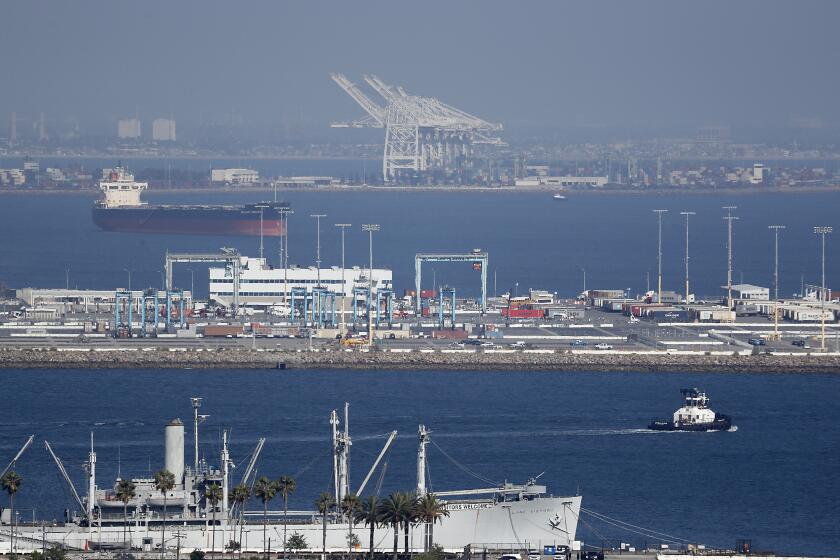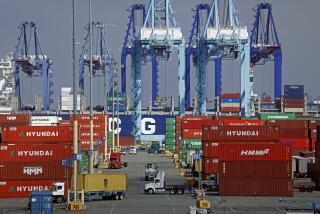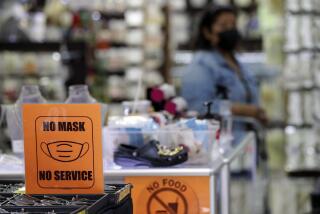The coronavirus will slam the brakes on California’s economic growth, study says
- Share via
California’s economic growth will slow this year as unemployment rises and job creation weakens as a result of the coronavirus outbreak, according to a UCLA forecast released Thursday.
The university economists stopped short of predicting a recession.
“Prior to the outbreak of the COVID-19 epidemic we were optimistic about the California economy,” wrote Jerry Nickelsburg, director of the Anderson School of Management forecast, noting that unemployment in December stood at just 3.9% and income growth was higher than in the U.S. overall despite the toll of the trade war on the state’s logistics industry.
But “that has now changed,” he wrote. “Supply chains are interrupted and transpacific travel has ground to a standstill. The epidemic is on, and how long it lasts and how severe it becomes is an open question.”
The nation’s largest port is hurting. That may be a leading indicator of the pain that’s in store for Southern California and the U.S. economy as businesses hunker down to deal with the rapidly expanding new coronavirus.
Among the forecast’s predictions:
- The state’s jobless rate will average 4.4% this year, growing to 4.5% in 2021 and dropping to 4.3% in 2022.
- Payrolls, which expanded by 1.79% from December 2018 to December 2019, will hardly grow at all in the third quarter of this year — by 0.3% — and by just 1% in 2020 and 2021, and 0.9% in 2022.
- Personal income growth adjusted for inflation will slow to 1.3% this year, followed by 1.7% in 2021 and 2022. It stood at 2% last year.
Last month, UCLA economists were in the middle of compiling data for their quarterly March report when the coronavirus hit the U.S. “As a result we tore up the forecast we were about to present,” wrote senior economist David Shulman, adding that the new forecast is “an attempt to distill incomplete and rapidly evolving information.”
Shulman predicted that U.S. GDP in the second and third quarters of this year would see “very modest increases of 1.3% and 0.6% respectively, compared to the 2% plus growth we previously forecast. You can view our forecast as the midpoint between the coronavirus having a very minimal effect to it causing a full-blown recession. Time will tell.”
Despite UCLA’s forecast for slower growth, however, Nickelsburg suggested that “the strength with which the California economy entered the current decade provides a buffer particularly for relatively short-term interruptions in supply chains and travel.… By 2022, we expect the economy to be more-or-less at the same levels it would have been absent this event.”
Some economists are less optimistic. Scott Anderson, chief economist for Bank of the West in San Francisco, said he forecasts “somewhat more severe impacts” than the UCLA economists, with a 50% likelihood of recession by the second or third quarter of this year.
In California, he said, “You’re going to see a significant drop in consumer demand — something you only see in recessions. We’re seeing cancellations of events. Employers have people working from home. That will impact bars and restaurants. With the drop in air travel, hotel occupancies are down.

“You’ll see pretty big declines in sales at retailers, maybe not in March because there’s a hoarding effect with people buying toilet paper at Costco. But we’re stealing from future sales, so you’ll see significant hits in April or May.”
Already, he noted, a widely watched index of U.S. service business activity, known as US Markit Services PMI, fell into contraction in February for the first time since 2016 and was at its worst level since October 2013.
“In California, service business employment makes up 87.1% of the total, higher than the national share of 86.0%,” Anderson said, “so this drop could be a bad sign for the economic and labor market outlook.”
Allan Zaremberg, president of the California Chamber of Commerce, said that when he went to get his car serviced at a BMW outlet in Sacramento this week, the mechanic complained that business had slowed since the coronavirus hit.
“People are probably more conservative in spending money,” Zaremberg said. “That may impact the macro economy in the long run.”
But he suggested that “the diversity of California’s economy, which doesn’t exist in other states, is a significant factor in buffering a crisis like this.” Zaremberg said, for example, that in addition to tourism, technology and logistics, the state has a large agricultural industry.
Still, Zaremberg said, “the level of uncertainty has ramped up in the last week. The general notion is, ‘Don’t panic.’ But every business should have a contingency plan based on the best-case scenario, the worst-case scenario and the most likely scenario — and how do you manage that.”
In Southern California, where 1 in 9 jobs is tied to international trade through the ports of Los Angeles and Long Beach, the trade war had already taken a toll, UCLA’s Nickelsburg wrote, with a decline in the movement of goods. The signing of an initial trade agreement with China had lifted hopes for a revival, but “the outbreak of COVID-19 mitigates against any increase in goods movement until the last quarter of the year,” he said.
With Chinese factories operating at about 40% of capacity, officials at the San Pedro Bay complex this week projected a 15% to 17% plunge in cargo volumes in the first quarter of this year from the first three months of 2019. Thousands of dockworkers and truckers have lost work.
California and Los Angeles face a housing crisis and a ‘demographic time bomb,’ leading to sluggish growth.
Economists cited several factors making California particularly vulnerable to a coronavirus-related downturn: the concentration of Pacific Rim trade, travel and tourism, and related leisure and hospitality businesses, along with the information technology sector that relies on trade.
Anderson also said that the steep decline in the stock market will “hit state tax revenues harder than most and put pressure on the state to cut expenses and slow job creation.” California’s tax structure relies heavily on income from wealthy residents, whose income is more dependent on the stock market than that of the general population.
Nickelsburg suggested a rise in demand for healthcare services and personal care services may partially offset the toll of the coronavirus on international tourism and on logistics. But, as with manufacturing, estimating the true effect is “problematic” because of the unknown nature of the virus threat, he wrote. “More is unknown than known.”
The UCLA forecast factored in data from earlier epidemics, including SARS, MERS, Ebola and especially the H1N1 swine flu of 2009-10, which alone killed 12,500 Americans.
But Shulman wrote, “What makes COVID-19 different from the prior epidemics … is that although less fatal, it is potentially far more contagious…. That triggered the economic shutdowns that have become so disruptive to the global economy.”
More to Read
Inside the business of entertainment
The Wide Shot brings you news, analysis and insights on everything from streaming wars to production — and what it all means for the future.
You may occasionally receive promotional content from the Los Angeles Times.












